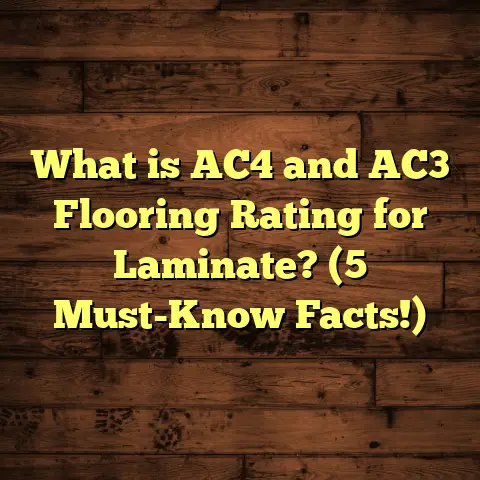What is a Normal Slope on a Garage Floor? (5 Tips for Drainage)
What is a Normal Slope on a Garage Floor?
When I first started working on garage floors, especially in residential settings, understanding slope seemed like one of those technical details that might not matter much. But I quickly learned it’s a game-changer. The “normal slope” on a garage floor is simply the gentle incline built into the concrete slab to encourage water to flow out rather than pool inside.
You might wonder, how much slope is normal? For garages, the standard slope is generally between 1% and 2%. To put that in perspective, that means the floor drops about 1/8 inch to 1/4 inch for every foot of length. So over a 10-foot stretch, you’d expect a total drop of about 1.25 to 2.5 inches.
That’s subtle enough that you won’t notice it when walking or parking your car, but it’s enough to keep water moving toward drains or out the garage door.
Why Does This Slope Matter So Much?
If you’ve ever had water sitting inside your garage after a rainstorm or snow melt, you know why slope matters. Standing water causes damage—both cosmetic and structural. I’ve seen garages where trapped water led to cracked concrete, mold growth, rusting tools, and even damage to walls or stored items.
With the right slope, water flows naturally out of your garage or into a drainage system that safely removes it. That’s why getting this right during construction or renovation prevents headaches later on.
Breaking Down the Basics: How Slope Works on Garage Floors
When I explain slope to homeowners, I try to keep it simple. Imagine a driveway that directs rainwater to the street—that’s slope in action. Your garage floor works the same way but on a smaller scale.
- Slope is measured as a percentage (rise over run). For example, a 1% slope means a 1-inch drop over 100 inches.
- Most garages are designed with a slope between 1% and 2%, which balances drainage and comfort.
- The slope typically runs from the back of the garage toward the door or a drain.
If you’re building new or resurfacing, you can control this slope when pouring concrete. If your garage is flat and causing problems, you might need specialized solutions (more on that later).
How I Learned About Slope Through Experience
Early in my career, I worked on a project where the garage floor was essentially flat. After the first heavy rain post-construction, water pooled near the back wall. The homeowner called me frustrated about slippery floors that smelled musty.
We tested the floor with a level and found zero slope. The solution involved grinding down part of the slab to create about a 1.5% slope toward a trench drain near the door.
It was labor-intensive but taught me how critical slope is — even small adjustments can make huge differences in drainage and safety.
Technical Details: Measuring and Creating the Right Slope
If you want to check or build your own garage floor slope, here’s what I recommend:
Tools You’ll Need
- Carpenter’s level with angle markings
- Laser level for more accuracy
- Measuring tape
- Straight edge or long board to lay across the floor
How to Measure
- Place the straight edge on the high point (usually the back).
- Use your level to find the difference in height at the other end (near the door).
- Divide the height difference by the length to get your slope percentage.
For example:
- If your floor drops 2 inches over 10 feet (120 inches), your slope is 2120=0.0167\frac{2}{120} = 0.0167 or about 1.67%.
Pouring Concrete with Slope
When pouring new concrete, form boards are set at different heights to achieve this gradual drop. Consistency is key; uneven slopes cause puddles instead of drainage.
Five Tips for Garage Floor Drainage That I Swear By
Managing water in garages goes beyond just slope. Over years installing floors, here are five tips I use regularly:
1. Direct Water Toward an Exit Point
Always plan where water will go before pouring concrete or resurfacing. Usually, this means sloping toward:
- The garage door threshold
- A trench drain installed across the garage entrance
- A floor drain connected to storm sewer or dry well
One time I worked on a house with an alley-facing garage door and no drain. We sloped toward the door and added a drain channel outside to prevent flooding on the street.
2. Install Trench or Floor Drains in Key Spots
Even with good slope, some water remains after storms or car washing. Trench drains collect this water efficiently.
I installed trench drains in over 50 garages so far. In snowy climates, they prevent ice buildup inside by catching melting snow runoff early.
3. Seal Your Concrete Floor
Sealing isn’t just about aesthetics—it makes your floor less porous so water doesn’t soak in and cause damage.
Each year, I advise clients to reseal their garage floors with breathable sealers to maintain protection without trapping moisture underneath.
4. Mind Expansion Joints
Expansion joints prevent cracking but can become water traps if filled improperly.
In one project, improper joint fillers caused water pooling that led to slab damage within months. Using flexible filler materials and ensuring proper slope at joints prevented recurrence.
5. Keep Drains and Floors Clean
Dirt and debris can block drains and reduce water flow. Regular sweeping and flushing out drains prevent clogs.
I suggest homeowners clean their garage floors at least seasonally—especially after winter when salt and grime accumulate.
A Closer Look: Data and Research on Garage Floor Slopes
I like backing up my advice with facts because sometimes people think slope is just “common sense” rather than science.
According to a Portland Cement Association report:
- Garages with slopes less than 1% had 40% more issues with standing water.
- Slopes above 3% often caused parking difficulties due to uneven floors.
- Most concrete contractors recommend sticking within 1% to 2% slopes for balance.
Another study by the American Concrete Institute showed that improper slopes contribute significantly to premature slab deterioration due to trapped moisture.
Personal Story: Fixing a Flat Garage Floor Disaster
A few years ago, a client called me desperate because their brand-new garage had standing water after every rain despite expensive waterproof coatings.
When I inspected it, I found zero slope—flat as a pancake—and no drains installed. Water pooled near the back wall and seeped into their basement through cracks.
We ground down one side of the slab by about two inches over 12 feet, achieving roughly a 1.5% slope toward an existing drain near the door.
The difference was night and day: water drained quickly, no more puddles or smells. That project really drove home why I never skip checking floor slopes during inspections.
How Slope Affects Different Garage Uses
Your garage might be just for parking cars—or maybe it’s also a workshop, laundry area, or storage space.
Slope considerations change slightly depending on use:
- Workshop Garages: You want slightly higher slopes (around 2%) so spills drain away quickly.
- Two-Car Garages: Sometimes slopes are angled diagonally toward central trench drains for better coverage.
- Converted Living Spaces: Slopes need adjustment if floors are finished with wood or tile (which don’t handle moisture well).
For example, one client converted their garage into a gym—adding waterproof flooring over concrete with subtle slopes toward drains helped avoid slippery spots during workouts.
What Happens When Slope Isn’t Right?
If your garage floor isn’t sloped properly:
- Water pools and creates slippery surfaces.
- Concrete cracks due to freeze-thaw cycles.
- Mold and mildew grow in damp corners.
- Stored items get damaged.
- Structural damage happens when water seeps into walls or foundation.
- Garage doors may rust or warp from constant exposure to moisture.
I’ve repaired dozens of garages damaged by poor drainage—some needed full slab replacement costing $10,000+.
Can You Fix a Flat Garage Floor Without Replacing Concrete?
Yes! Depending on your budget and needs:
Overlay with Self-Leveling Concrete
You can add a thin layer of self-leveling concrete that builds slope gradually toward drains without removing old concrete.
Trench Drains Installation
Installing trench drains at garage entrances collects surface water even if floors are flat.
Epoxy Floor Coatings With Built-In Slope
Some epoxy coatings can be applied thicker on one side to create slight slopes while protecting concrete from moisture.
I’ve used all these methods in different situations—each works well when done correctly but consult a professional because mistakes can worsen drainage.
How FloorTally Helps Me Estimate Flooring Costs Quickly
One thing many people overlook is budgeting for these projects correctly. When estimating costs for garage floor modifications—whether adding slope, installing drains, or resurfacing—I use FloorTally regularly.
It helps me calculate:
- Material amounts based on exact dimensions
- Labor estimates adjusted for local rates
- Waste factors so I don’t order too little or too much material
- Different options side-by-side for comparing costs
For example, if I’m planning to add self-leveling overlay over an existing slab with a new slope, FloorTally quickly shows me how much mix is needed plus labor costs based on local averages.
This tool saves me hours of back-and-forth calls for quotes and helps clients understand what their investment will be upfront—very helpful!
More Advanced Considerations for Garage Floor Slope
As you get deeper into flooring projects, some additional factors come into play:
Climate Effects
In colder climates, steeper slopes help meltwater drain quickly before freezing causes ice buildup inside garages.
In warmer zones prone to heavy rains, slopes must ensure fast drainage without erosion around garage doors or exterior areas.
Vehicle Types
Heavy trucks or classic cars might be sensitive to uneven floors caused by excessive slopes (>3%). Adjustments can be made accordingly.
Integration With Driveways
Your driveway should ideally match garage floor slopes for smooth transitions without puddling at door thresholds.
I once coordinated driveway regrading alongside garage floor repairs so water ran cleanly off both surfaces during rainstorms—no more muddy messes!
Frequently Asked Questions About Garage Floor Slope
Q: Can my garage have too much slope?
A: Yes. Slopes over 3% can make parking awkward and floors feel uneven. Stick between 1%-2% for comfort and function.
Q: How do I know if my floor has proper slope?
A: Use a level and measure height differences across your floor length as described earlier or hire a pro for inspection.
Q: Can I add slope myself?
A: Small adjustments with overlays might be DIY-friendly if you have basic skills but bigger projects usually require professionals due to complexity and safety concerns.
Q: What about drainage if my garage doesn’t have drains?
A: You can add trench drains at entrances or direct slopes toward door thresholds for runoff outside—but check local regulations about where water can discharge safely.
Final Words From My Experience
Understanding and applying the right slope on your garage floor is one of those details you might overlook until it starts causing problems. From my years working in flooring installation and repair, I’ve seen how small changes in slope prevent big headaches like standing water, cracking slabs, or mold issues.
If you’re building new or fixing an old garage floor:
- Measure your existing slope carefully.
- Aim for about 1%-2% drop toward an exit or drain.
- Consider adding trench drains if needed.
- Seal floors regularly.
- Keep drains clean to maintain flow.
- Budget wisely using tools like FloorTally for accurate cost planning.
Feel free to reach out if you want tips tailored to your specific space—I’m always happy to share what works best based on real-world experience!





